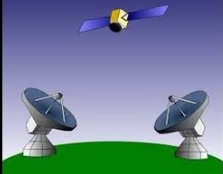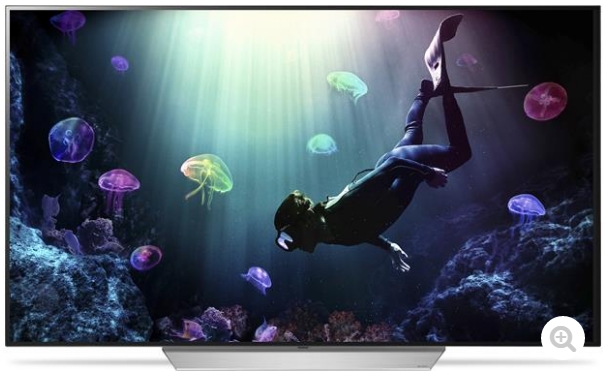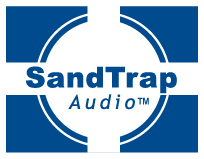Ed's
AV Handbook
Batting Practice for the AV Professional
and primer for the novice
Chapter 4 Page 3
Video Reproduction
Digital Television
Off-air, Cable, Satellite, Internet
Digital TV decodes five
voltages from digitally encoded component
video* to create a television
picture.
*refer to previous page
*refer to previous page
1. Red
2. Green
3. Blue
4. Horizontal Sync
5. Vertical Sync
(Horizontal and vertical sync
are the start and finish points of each video frame.)
A digital TV decoder processor converts component video to
red, green, blue sub-pixels while progressively building each
picture frame line by line. OLED, IOLED, Micro LED, LCD,
and plasma processors hold the progressive-lines of data until
they have a complete frame. They then flash the entire
video frame to the television screen. DLP projectors
build each frame progressively line by line on the
screen. Digital TV Broadcast / Cable
Digital broadcasted - local off-air & satellite - component video does not fit within allocated data bandwidth and storage as is. Broadcasters reduce the data with MPEG video compression. Off-air ATSC TV also employs ATSC 8VSB codec, and cable TV providers use QAM codec to accommodate MPEG audio and video compression.Handbook
Notes: codec is an acronym for
compress/decompress.
MPEG Video Compression
MPEG video compression is a
cycle of incomplete video frames inserted between complete
uncompressed frames. MPEG compression eliminates
redundant video data. It is somewhat similar to
animation. Unchanging elements of moving scenes, such
as the static background of a blue sky, are held and
repeated frame after frame. Changing data of motion
passes without interruption.
The data reduction, plus the number of incomplete frames placed between complete frames, is determined by the version of MPEG employed: MPEG-2, MPEG-4 AVC H.264, MPEG HEVC H.265, MPEG VCC H.266. Each succeeding version increases the amount of data reduction.
- MPEG2 supports ATSC HDTV off-air broadcast.
- MPEG4 supports satellite broadcast.
- MPEG HEVC H.265 (High Efficiency Video Coding) supports ATSC 3.0 Next GenTV, UltraHDTV.
- MPEG VCC H.266 (Versatile Video Coding) supports ATSC 3.0 NextGenTV, UltraHDTV, UHD-8K TV, & UHD-16K TV.
The data reduction, plus the number of incomplete frames placed between complete frames, is determined by the version of MPEG employed: MPEG-2, MPEG-4 AVC H.264, MPEG HEVC H.265, MPEG VCC H.266. Each succeeding version increases the amount of data reduction.
- MPEG2 supports ATSC HDTV off-air broadcast.
- MPEG4 supports satellite broadcast.
- MPEG HEVC H.265 (High Efficiency Video Coding) supports ATSC 3.0 Next GenTV, UltraHDTV.
- MPEG VCC H.266 (Versatile Video Coding) supports ATSC 3.0 NextGenTV, UltraHDTV, UHD-8K TV, & UHD-16K TV.
ATSC 8VS
The final stage of an off-air digital ATSC broadcast also employs ATSC 8VSB RF modulation. 8VSB divides MPEG video and audio into interleaving packets of data called PIDS. It is a continuing cycle of a video PID followed by an audio PID. An ATSC 8VSB television tuner decoder restores order.
QAM
The digital cable TV provider's final stage utilizes QAM modulation. QAM is similar to 8VSB interweaving of the video and audio data. As an 8VSB, a QAM cable television tuner decodes and restores order.
Satellite TV Distribution
An umbrella of communication
satellites distributes TV programming to local broadcasters,
cable companies, and 'small dish' satellite providers.
Several dozen communication satellites hover in
geosynchronous orbit more than 22,000 miles above the
equator of the earth. They receive and redirect
programming to your TV provider's 'tree farm' of large dish
satellite antennas.

- Local broadcasters
re-transmit programming via a broadcast tower to indoor and
rooftop antennas.
- Cable TV providers redistribute programming via cable wired directly to residences.
- Small dish satellite providers up-link their programming to proprietary satellites that bounce the programming back to small rooftop dish antennas.
Dish antenna, why?
A local TV broadcaster may engage thousands of watts of broadcast power. As a result, the local TV receiving antenna can be as little as a "rabbit ear" antenna sitting on the TV. In contrast, satellites are limited to only five to fifteen watts of down-link broadcast power. Also, they broadcast at radio frequencies that are impractical for a satellite receiving tuner to manage. Consequently, the satellite receiving system needs a major-assist.
Assistance comes in the form of a satellite dish with a low-noise-block-feed-horn (LNBF) mounted in front of the satellite dish. The satellite dish magnifies incoming signal hundreds of fold by reflecting and focusing the energy at a mounting arm that holds the antenna element located in the LNBF. The LNBF amplifies the signal still further and shifts the incoming-signal from the 12GHz region to the more manageable neighborhood of 950 MHz to 1450 MHz. Small dish operators also employ MPPEG4 digital compression to squeeze hundreds of channels within their bandwidth. The combination of the dish antenna, the LNBF, and MPEG4 produces a signal that a satellite receiver can handle and display on a TV.
- Cable TV providers redistribute programming via cable wired directly to residences.
- Small dish satellite providers up-link their programming to proprietary satellites that bounce the programming back to small rooftop dish antennas.
Dish antenna, why?
A local TV broadcaster may engage thousands of watts of broadcast power. As a result, the local TV receiving antenna can be as little as a "rabbit ear" antenna sitting on the TV. In contrast, satellites are limited to only five to fifteen watts of down-link broadcast power. Also, they broadcast at radio frequencies that are impractical for a satellite receiving tuner to manage. Consequently, the satellite receiving system needs a major-assist.
Assistance comes in the form of a satellite dish with a low-noise-block-feed-horn (LNBF) mounted in front of the satellite dish. The satellite dish magnifies incoming signal hundreds of fold by reflecting and focusing the energy at a mounting arm that holds the antenna element located in the LNBF. The LNBF amplifies the signal still further and shifts the incoming-signal from the 12GHz region to the more manageable neighborhood of 950 MHz to 1450 MHz. Small dish operators also employ MPPEG4 digital compression to squeeze hundreds of channels within their bandwidth. The combination of the dish antenna, the LNBF, and MPEG4 produces a signal that a satellite receiver can handle and display on a TV.
Internet Streaming / IPTV
Expanding Internet bandwidth has allowed Internet protocol television (IPTV) to become the leading means of TV program distribution via Internet service providers (ISP) -- local cable TV, telephone DSL, cellular phone, satellite, and NextGenTV terrestrial broadcast.
H.264 AVC (Advanced Video Compression) compression supports most Internet video streaming.
Internet service providers
deliver programming via a managed or unmanaged
network. An un-managed network is a single programming
website such as Netflix, Amazon, Hulu. A managed
multichannel-video-program-distributor (MVPD), such as
YouTubeTV, offers a package of un-managed sites.
Both are known as OTT (over the top) programming.
Both are known as OTT (over the top) programming.
Digital TV Result
Red,
Green, Blue,
horizontal sync, and vertical sync data, derived from
television camera CCD sensors, are converted to component
video. A digital TV provider compresses the component video
within allocated data storage. The digital TV restores
the component video data to RGBHV to recreate the original
sequence of pixel framed images on the TV screen
Site Menu
Home
Table of
Contents
Handbook Chapters
1 AV
Terms
2 AV Physics
3 Sound Reproduction
4 Video Reproduction
5 The AV System Sequence
6 The Room, Speaker, & TV
7 Acoustical Strategy - Small Room
8 Home Theater by Design
9 AV Sales Training
10 AV Business & Marketing
Contact
About



